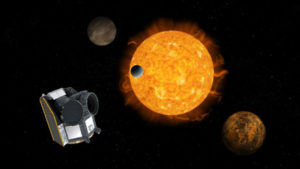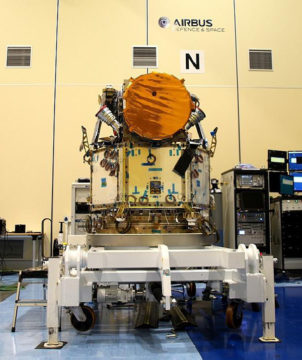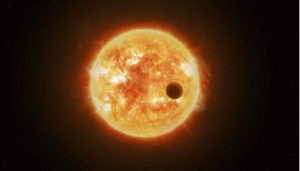The European Cheops mission launched Wednesday on a mission to improve our understanding of hundreds of known exoplanets.

ESA / ATG medialab
Early Wednesday morning, a Russian Soyuz rocket successfully launched the first truly European space mission dedicated to the study of extrasolar planets. Unlike NASA’s Kepler and TESS missions, the Characterising Exoplanet Satellite (Cheops) won’t hunt for new planets. Instead, it will study in detail a few hundred known exoplanets transiting bright stars.
Transiting planets are detected when they barely dim their star’s light as they pass across it. But while a transit may betray a planet’s presence, other details can be difficult to obtain.
“A key thing is that we will have the precision needed to precisely measure the sizes of planets smaller than Neptune, which we cannot do from the ground,” says Kate Isaak, the European Space Agency (ESA) project scientist for the mission, which is a partnership of ESA and the Swiss Space Office. Size is crucial for determining a planet’s general properties, such as composition.
The Cheops Mission

Airbus
Cheops is about 1.5 meters (5 feet) across and weighs just under 300 kilograms (660 pounds). It sports a 32-centimeter telescope and an electronic CCD detector that repeatedly measures stars’ brightnesses to a precision of 20 parts per million every 30 to 60 seconds. The ultra-high precision makes it a “very Swiss” project, quips principal investigator Willy Benz (University of Bern).
Combined with knowledge of the star's size, gleaned from ESA's Gaia mission, Cheops' precise observations of planetary transits will yield exact values for the planets’ sizes. Mass determinations from follow-up radial velocity observations will then provide information on the planet's composition.
According to Isaak, a number of interesting exoplanets are on the Cheops target list, including the very hot super-earth 55 Cancri e and the hottest known gas giant, KELT-9b. However, “we will not observe Trappist 1,” she says. “It is too faint for Cheops.”
Precise light curves during the ingress and the egress of an exoplanet may shed light on the existence – and the vertical structure – of any atmosphere. In principle, the Cheops observations might also provide evidence for the existence of exomoons. “This will be challenging,” says Isaak, “but we will try.” Benz warns that a moon can only be detected if it is relatively large compared to the planet. “We just don’t know how many planets have sizeable moons,” he says.
The total cost of the mission (some 100 million euros) is shared equally by ESA and a consortium of 11 European countries, led by Switzerland, which contributes approximately 30 million euros. “It’s a small mission, but a complex organization,” notes Benz. CHEOPS is the first small mission in ESA’s Cosmic Vision 2015-2025 program.
Cheops Team and Timeline

ESA / ATG medialab
The 30-person Cheops science team is led by Nobel laureate Didier Queloz (University of Geneva), co-discoverer of the first exoplanet orbiting a Sun-like star. A fifth of the observing time on the satellite is open for guest observing programs through ESA. Proposals that make use of the unique capabilities of Cheops will be selected on the basis of their scientific merit, “as long as the targets are not on the Cheops target list,” says Isaak.
Benz hopes that the nominal mission duration of 3.5 years will be extended. However, he adds that the measurement precision will slowly start to deteriorate after five years or so — the result of cosmic rays impacting the CCD cameras.
Cheops is the first European exoplanet mission, but it won’t be the last. In 2026, the Planetary Transits and Oscillations of stars (PLATO) mission will search up to one million stars for transiting, Earth-like planets. Two years later, Atmospheric Remote-sensing Infrared Exoplanet Large-survey (ARIEL) is going to study the atmospheres of at least 1,000 known exoplanets.
 0
0
Comments
You must be logged in to post a comment.